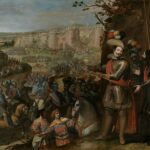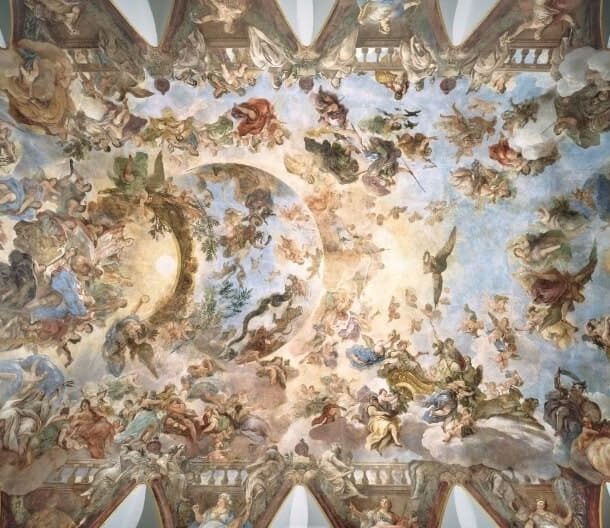
In Carducho’s work, the Duke of Feria appears in the foreground on a rocky elevation commanding his officers. He wears the same armour and headdress as in the scene of the relief of the square of Constanza, pointing to the battlefield with his right hand and holding the flare or baton of command with his left. In another, lower compositional plane, a squire approaches his horse, while in the intermediate planes there is a squad of armoured horsemen, some of them galloping down a cliff-side path to come to the aid of the troops fighting on the plain in front of the fortress. In the background, the assault on the city is shown in great detail, with soldiers scaling the walls and part of the troops entering a breach in the wall through the gates. A soldier of the Duke of Feria’s troops waves the white flag with the red flag of Burgundy as a sign of victory on one of the cylindrical towers. The Spanish victory meant the restoration of a line of communication between Constance and Basel.
Collection: Images
Project: 5. Power and powers in the history of Europe: oligarchies, political participation and democracy., 6. Under a cloak of terror: violence and armed conflict in Europe.
Chronology: XVII
Scope: Secondary Education, Baccalaureate, University
Resource type: Image
Format: Oil on canvas (297 x 357 cm)
Source: Museo Nacional del Prado (Madrid)
Language: Spanish
Date: 1634
Owner: Álvaro Romero González (Modernalia)
Identifier: P000637
Copyright: Museo del Prado (Madrid)
Abstract: Representation of the expugnation of Rheinfelden, a work that forms part, along with others, of the commemoration of a series of land and naval victories that were won by the armies of the Hispanic Monarchy during the first period of the Thirty Years' War. These canvases were destined for the Salón de Reinos of the Buen Retiro Palace.
Image
Tags






